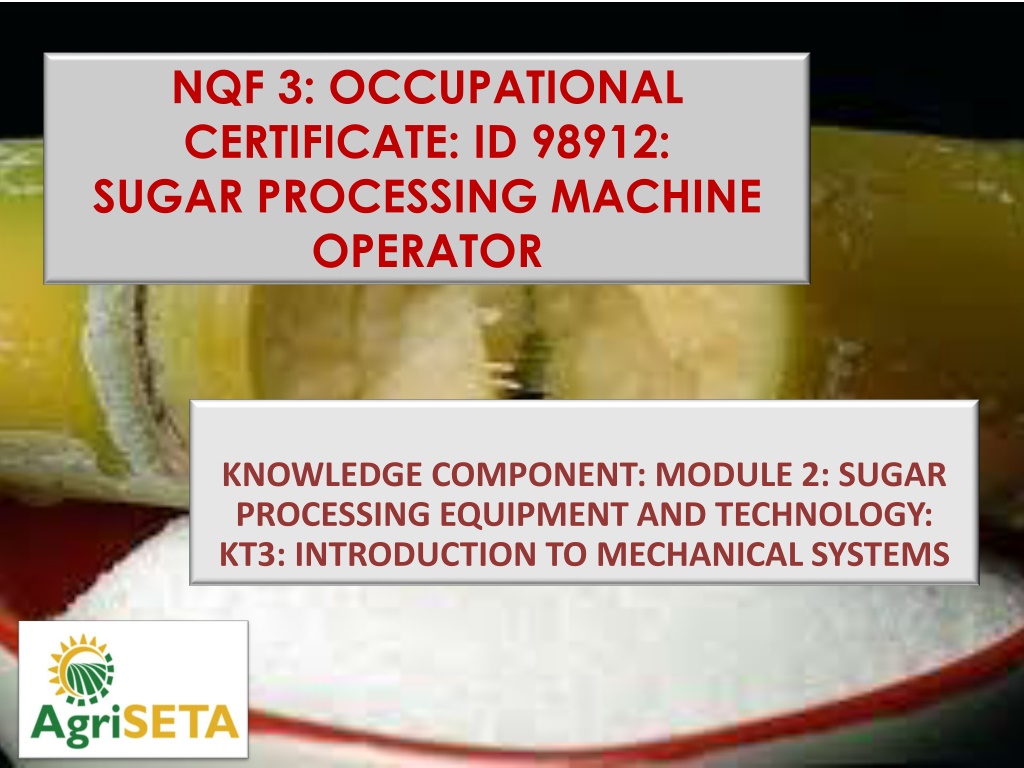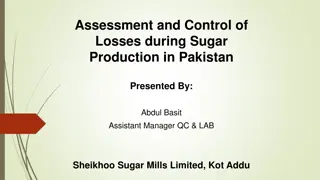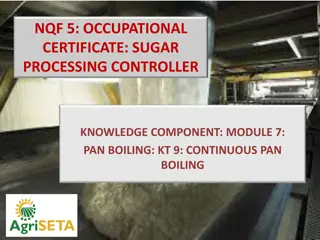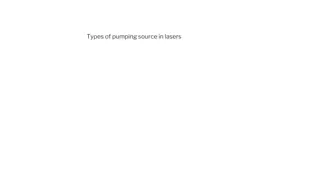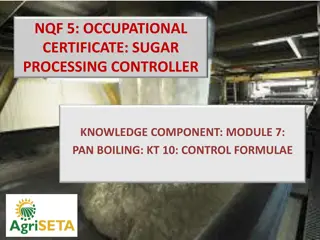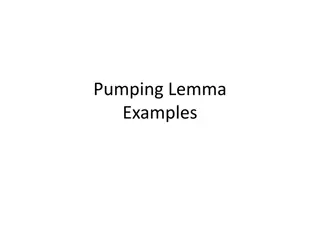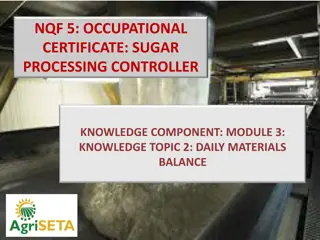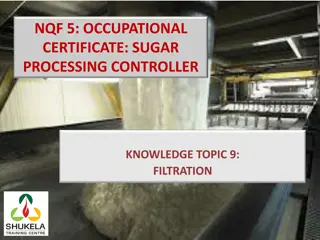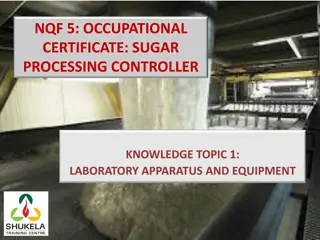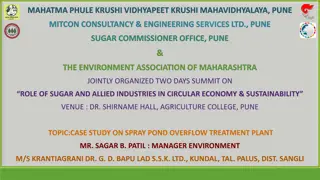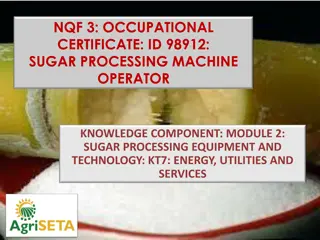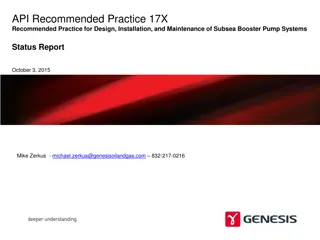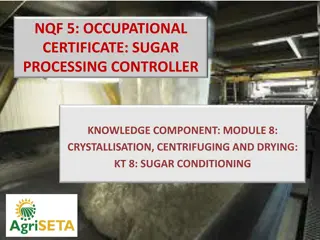Understanding Material Handling Equipment and Pumping Systems in Sugar Processing
Material handling equipment plays a crucial role in the movement and storage of materials, goods, and products in various industries, while pumping systems, especially pipes, are essential for transferring liquids or gases. This content discusses the types of material handling equipment, such as actuators and conveyors, and details the importance of pipes, fittings, and connections in pumping systems for sugar processing operations. Proper knowledge of these systems is essential for ensuring efficiency and productivity in sugar processing industries.
Download Presentation

Please find below an Image/Link to download the presentation.
The content on the website is provided AS IS for your information and personal use only. It may not be sold, licensed, or shared on other websites without obtaining consent from the author. Download presentation by click this link. If you encounter any issues during the download, it is possible that the publisher has removed the file from their server.
E N D
Presentation Transcript
NQF 3: OCCUPATIONAL CERTIFICATE: ID 98912: SUGAR PROCESSING MACHINE OPERATOR KNOWLEDGE COMPONENT: MODULE 2: SUGAR PROCESSING EQUIPMENT AND TECHNOLOGY: KT3: INTRODUCTION TO MECHANICAL SYSTEMS
Material Handling Equipment Material handling equipment is all equipment that relates to the movement, storage, control and protection of materials, goods and products throughout the process of manufacturing, distribution, consumption and disposal. Material handling equipment is used to: increase throughput, control costs, and maximize productivity Types of Material Handling Equipment includes: Actuators converts energy into torque Elevators Conveyors (Slat or rake type)
Pumping Systems - Pipes Pipes transfer liquids or gases from one point to another, often with the help of pumps Different types of materials are used in the manufacture of pipes In milling it will be galvanised or black piping Pipes are sized according to their inside diameter and wall thickness Tubing is sized according to its outside diameter or its inside diameter
Pumping Systems Pipes (cont.) Pipes have to be clamped in order to carry out threading or cutting chain vices are used When threading pipe the thread must match that of the fittings or the joint will leak There are two methods of cutting pipes pipe cutter or hacksaw
Pumping Systems Pipes (cont.) The most common fittings used with galvanised piping are malleable cast iron pipe fittings. These fittings are used for water, oil, gas, steam or air services. The maximum working pressures allowed are 140kPa for oil, gas, steam or air. However, the fittings have a high factor of safety over the specified working pressures. For higher pressure installations, steel fittings and wrought steel fittings are used
Pumping Systems Pipes (cont.) Reducing bushes Holder bats Caps Plugs Johnson couplings Backnut Saddles and Clamps Swage Fitting Stoptap Pipe fittings include: Bends Springs Elbows T-pieces and Crosses Reducing elbows Sockets Hexagon nipples Unions
Pumping Systems Pipes (cont.) The joints and connections of a piping installation must be sealed to prevent leaking. There are two types of material used to seal piping connections,: PTFE tape PTFE tape is white thermoplastic material with a waxy texture in the form of a roll of tape. PTFE is an abbreviation for polytetrafluoro-ethylene. It is non-flammable and resists chemical reaction. It has an electrical resistance and a low co-efficient of friction. Used on branch joints Hemp rope A natural product taken from the fibre of a plant, used to make canvas and rope. Used on any other joints than branch joints These products are wound around the thread of the pipe, onto which a fitting is to be screwed.
Pumping Systems Pipes (cont.) Factories and plants colour code pipes according to the substance flowing through them This is a safety precaution It helps the maintenance staff to identify them easily
Pumping Systems Pipes (cont.) Pipes are lagged or jacketed to prevent the loss of heat or the effect of temperature or oxidation. If a pipe is lagged, the colour still applies and must be retained if the lagging is removed. Different materials are used to make pipe lagging, and the type depends on the application. The lagging may be needed to: Insulate at very high or very low temperatures, Resist acids, fire, water or wear. The material used is also dependant on the size of pipes and the space between them.
Pumping Systems Valves Valves are used to: Regulate Isolate Control, and Shut off .the flow of liquids and gases in a pipe line. Many different valves available for many different uses. Valves are manufactured from steel, bronze and non-metallic materials such as Bakelite or other resinous derivatives. Non metallic materials are used for valves in systems when an acid is present in the circulated substance. Valves range in size from 3mm to 100mm for valves with screwed ends and between 50mm and 500mm for vales with flanged ends.
Pumping Systems Valves (cont.) Gate valves Diaphragm valves Safety relief valves
Pumping Systems Valves (cont.) Non-return valves Globe valves Butterfly valves
Pumping Systems Valves (cont.) Ball valves Slide valves Float valves
Pumping Systems Cleaning and Repair It is the duty of a maintenance officer to ensure : Correct running order of a plant, To repair and correct any fault and To take action to prevent it from happening again. All machines have certain parts that are prone to wear and breakages. All machines must therefore be regularly checked so that such parts can be repaired or replaced before they cause a major breakdown. Effective maintenance of equipment according to the manufacturer s instructions to prevent breakdown, is known as routine maintenance. Issues to be considered when stripping and cleaning include: Manufacturer s instructions Sequence of removal of parts Dismantling techniques (sketching and proof marking) Switching off power General safety Wear correct PPE s
Drives Motors and Turbines A motorcan be defined as A machine, especially one powered by electricity or internal combustion, that supplies motive power for a vehicle or for another device with moving parts A turbine is a device that harnesses the kinetic energy of some fluid such as water, steam, air, or combustion gases and turns this into the rotational motion of the device itself. The 4 types of turbines are: Water turbines Steam turbines Gas turbines Wind turbines
Drives - Hydraulics Modern hydraulics is based on a principle formulated by French scientist Blaise Pascal in the 1700 s Relates to confined fluids transmitting power, multiplying force and modifying motions. Pressure in a confined fluid is equal at all points in the fluid, and acts in all directions. Hydraulic fluid is mostly refined oil, and has three main functions in a hydraulic system: To transmit power To lubricate To cool the system
Drives Hydraulics (cont.) A simple hydraulic system can operate with the following basic components: Reservoir, Pump, Actuator, Pressure relief valve, Piping, Hydraulic fluid A hydraulic accumulator is a storage chamber in which fluid energy is accumulated and from which it can be withdrawn.
Drives - Gears A gear can be defined as: a toothed wheel that works with others to alter the relation between the speed of a driving mechanism (such as the engine of a vehicle) and the speed of the driven parts (the wheels). Types of gears include: Spur gears Helical Double Worm and wheel Bevel Rack and pinion
Drives Gears (cont.) Spur gears Helical Double
Drives Gears (cont.) Worm and wheel Bevel Rack and pinion
Drives Gears Drives Compound gear drives Planetary gear trains Simple gear drives
Drives - Clutches A clutch is a device that allows two components to be engaged or disengaged, whilst one or both of the components is in motion. When a rotating shaft is connected to a stationary shaft, a clutch must be fitted to turn the stationary shaft and give the option of engaging and disengaging drive power when required. Clutches as used in motors connected to gearboxes and in assemblies where a driving shaft is connected to a driven shaft. Types include: Positive Friction Centrifugal Hydraulic
Drives Clutches (cont.) Function is to transmit torque from a power source (prime mover) directly or via machine parts to the working machine and to provide the possibility to interrupt the transmitted torque. I.e. Transmit motion from the driving to the driven member by the friction between the engaging surfaces Are built in many different designs Driving and driven members of friction clutches are held in engagement by means of spring pressure, although pneumatic pressure, hydraulic pressure and electromagnets may be employed. Definition: Torque is any force that causes or tends to cause rotation. It is the ability of a shaft to cause rotation.
Clutches Positive-type Claw clutch Spiral claw clutch
Clutches Friction-type Cone clutch Plate clutches Single plate clutch Multi plate clutch
Clutches Centrifugal Spring weighted or spring-controlled centrifugal clutch Loose weight or free-wheeling centrifugal clutch
Means of operation Clutches Mechanical Torque-limiting Magnetic-limiting Hydraulic and pneumatic
Further equipment found in Sugar Mills Scales Fans Compressors Pumps Vacuum pumps Water pumps
